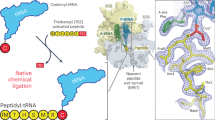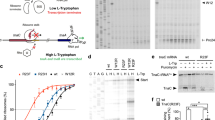Abstract
Regulation of gene expression in response to the changing environment is critical for cell survival. For instance, binding of macrolide antibiotics to the ribosome promotes translation arrest at the leader open reading frames ermCL and ermBL, which is necessary for inducing the antibiotic resistance genes ermC and ermB. Cladinose-containing macrolides such as erythromycin (ERY), but not ketolides such as telithromycin (TEL), arrest translation of ermCL, whereas either ERY or TEL stall ermBL translation. How the ribosome distinguishes between chemically similar small molecules is unknown. We show that single amino acid changes in the leader peptide switch the specificity of recognition of distinct molecules, triggering gene activation in response to ERY alone, to TEL alone or to both antibiotics or preventing stalling altogether. Thus, the ribosomal response to chemical signals can be modulated by minute changes in the nascent peptide, suggesting that protein sequences could have been optimized for rendering translation sensitive to environmental cues.
This is a preview of subscription content, access via your institution
Access options
Subscribe to this journal
Receive 12 print issues and online access
$259.00 per year
only $21.58 per issue
Buy this article
- Purchase on Springer Link
- Instant access to full article PDF
Prices may be subject to local taxes which are calculated during checkout




Similar content being viewed by others
References
Weisblum, B. Erythromycin resistance by ribosome modification. Antimicrob. Agents Chemother. 39, 577–585 (1995).
Ramu, H., Mankin, A. & Vazquez-Laslop, N. Programmed drug-dependent ribosome stalling. Mol. Microbiol. 71, 811–824 (2009).
Vazquez-Laslop, N., Thum, C. & Mankin, A.S. Molecular mechanism of drug-dependent ribosome stalling. Mol. Cell 30, 190–202 (2008).
Arenz, S. et al. Molecular basis for erythromycin-dependent ribosome stalling during translation of the ErmBL leader peptide. Nat. Commun. 5, 3501 (2014).
Schlünzen, F. et al. Structural basis for the interaction of antibiotics with the peptidyl transferase centre in eubacteria. Nature 413, 814–821 (2001).
Tu, D., Blaha, G., Moore, P.B. & Steitz, T.A. Structures of MLSBK antibiotics bound to mutated large ribosomal subunits provide a structural explanation for resistance. Cell 121, 257–270 (2005).
Bulkley, D., Innis, C.A., Blaha, G. & Steitz, T.A. Revisiting the structures of several antibiotics bound to the bacterial ribosome. Proc. Natl. Acad. Sci. USA 107, 17158–17163 (2010).
Dunkle, J.A., Xiong, L., Mankin, A.S. & Cate, J.H. Structures of the Escherichia coli ribosome with antibiotics bound near the peptidyl transferase center explain spectra of drug action. Proc. Natl. Acad. Sci. USA 107, 17152–17157 (2010).
Tenson, T., Lovmar, M. & Ehrenberg, M. The mechanism of action of macrolides, lincosamides and streptogramin B reveals the nascent peptide exit path in the ribosome. J. Mol. Biol. 330, 1005–1014 (2003).
Kannan, K., Vázquez-Laslop, N. & Mankin, A.S. Selective protein synthesis by ribosomes with a drug-obstructed exit tunnel. Cell 151, 508–520 (2012).
Davis, A.R., Gohara, D.W. & Yap, M.N. Sequence selectivity of macrolide-induced translational attenuation. Proc. Natl. Acad. Sci. USA 111, 15379–15384 (2014).
Kannan, K. et al. The general mode of translation inhibition by macrolide antibiotics. Proc. Natl. Acad. Sci. USA 111, 15958–15963 (2014).
Weisblum, B. Insights into erythromycin action from studies of its activity as inducer of resistance. Antimicrob. Agents Chemother. 39, 797–805 (1995).
Gupta, P., Sothiselvam, S., Vázquez-Laslop, N. & Mankin, A.S. Deregulation of translation due to post-transcriptional modification of rRNA explains why erm genes are inducible. Nat. Commun. 4, 1984 (2013).
Horinouchi, S. & Weisblum, B. Posttranscriptional modification of mRNA conformation: mechanism that regulates erythromycin-induced resistance. Proc. Natl. Acad. Sci. USA 77, 7079–7083 (1980).
Gryczan, T.J., Grandi, G., Hahn, J., Grandi, R. & Dubnau, D. Conformational alteration of mRNA structure and the posttranscriptional regulation of erythromycin-induced drug resistance. Nucleic Acids Res. 8, 6081–6097 (1980).
Arenz, S. et al. Drug sensing by the ribosome induces translational arrest via active site perturbation. Mol. Cell 56, 446–452 (2014).
Mayford, M. & Weisblum, B. The ermC leader peptide: amino acid alterations leading to differential efficiency of induction by macrolide-lincosamide-streptogramin B antibiotics. J. Bacteriol. 172, 3772–3779 (1990).
Kamimiya, S. & Weisblum, B. Induction of ermSV by 16-membered-ring macrolide antibiotics. Antimicrob. Agents Chemother. 41, 530–534 (1997).
Vázquez-Laslop, N. et al. Role of antibiotic ligand in nascent peptide-dependent ribosome stalling. Proc. Natl. Acad. Sci. USA 108, 10496–10501 (2011).
Xiong, L., Shah, S., Mauvais, P. & Mankin, A.S. A ketolide resistance mutation in domain II of 23S rRNA reveals the proximity of hairpin 35 to the peptidyl transferase centre. Mol. Microbiol. 31, 633–639 (1999).
Hansen, L.H., Mauvais, P. & Douthwaite, S. The macrolide-ketolide antibiotic binding site is formed by structures in domains II and V of 23S ribosomal RNA. Mol. Microbiol. 31, 623–631 (1999).
Llano-Sotelo, B. et al. Binding and action of CEM-101, a new fluoroketolide antibiotic that inhibits protein synthesis. Antimicrob. Agents Chemother. 54, 4961–4970 (2010).
Subramanian, S.L., Ramu, H. & Mankin, A.S. in Antibiotic Drug Discovery and Development (eds. Dougherty, T.J. & Pucci, M.J.) 455–484 (Springer, 2011).
Bailey, M., Chettiath, T. & Mankin, A.S. Induction of erm(C) expression by noninducing antibiotics. Antimicrob. Agents Chemother. 52, 866–874 (2008).
Ramu, H. et al. Nascent peptide in the ribosome exit tunnel affects functional properties of the A-site of the peptidyl transferase center. Mol. Cell 41, 321–330 (2011).
Sothiselvam, S. et al. Macrolide antibiotics allosterically predispose the ribosome for translation arrest. Proc. Natl. Acad. Sci. USA 111, 9804–9809 (2014).
Voorhees, R.M., Weixlbaumer, A., Loakes, D., Kelley, A.C. & Ramakrishnan, V. Insights into substrate stabilization from snapshots of the peptidyl transferase center of the intact 70S ribosome. Nat. Struct. Mol. Biol. 16, 528–533 (2009).
Zaher, H.S., Shaw, J.J., Strobel, S.A. & Green, R. The 2′-OH group of the peptidyl-tRNA stabilizes an active conformation of the ribosomal PTC. EMBO J. 30, 2445–2453 (2011).
Englander, M.T. et al. The ribosome can discriminate the chirality of amino acids within its peptidyl-transferase center. Proc. Natl. Acad. Sci. USA 112, 6038–6043 (2015).
Bonnefoy, A., Girard, A.M., Agouridas, C. & Chantot, J.F. Ketolides lack inducibility properties of MLS(B) resistance phenotype. J. Antimicrob. Chemother. 40, 85–90 (1997).
Sutcliffe, J. & Leclercq, R. in Macrolide Antibiotics (eds. W. Schönfeld & H.A. Kirst) 281–318 (Birkhäuser, 2002).
Oh, T.G., Kwon, A.R. & Choi, E.C. Induction of ermAMR from a clinical strain of Enterococcus faecalis by 16-membered-ring macrolide antibiotics. J. Bacteriol. 180, 5788–5791 (1998).
Gupta, P., Kannan, K., Mankin, A.S. & Vázquez-Laslop, N. Regulation of gene expression by macrolide-induced ribosomal frameshifting. Mol. Cell 52, 629–642 (2013).
Vázquez-Laslop, N., Ramu, H., Klepacki, D., Kannan, K. & Mankin, A.S. The key function of a conserved and modified rRNA residue in the ribosomal response to the nascent peptide. EMBO J. 29, 3108–3117 (2010).
Johnston, T.C., Thompson, R.B. & Baldwin, T.O. Nucleotide sequence of the luxB gene of Vibrio harveyi and the complete amino acid sequence of the beta subunit of bacterial luciferase. J. Biol. Chem. 261, 4805–4811 (1986).
Trabuco, L.G., Villa, E., Mitra, K., Frank, J. & Schulten, K. Flexible fitting of atomic structures into electron microscopy maps using molecular dynamics. Structure 16, 673–683 (2008).
Trabuco, L.G., Villa, E., Schreiner, E., Harrison, C.B. & Schulten, K. Molecular dynamics flexible fitting: a practical guide to combine cryo-electron microscopy and X-ray crystallography. Methods 49, 174–180 (2009).
Trabuco, L.G. et al. The role of L1 stalk-tRNA interaction in the ribosome elongation cycle. J. Mol. Biol. 402, 741–760 (2010).
Jühling, F. et al. tRNAdb 2009: compilation of tRNA sequences and tRNA genes. Nucleic Acids Res. 37, D159–D162 (2009).
Humphrey, W., Dalke, A. & Schulten, K. VMD: visual molecular dynamics. J. Mol. Graph. 14, 33–38, 27–28 (1996).
Phillips, J.C. et al. Scalable molecular dynamics with NAMD. J. Comput. Chem. 26, 1781–1802 (2005).
Cornell, W.D. et al. A second generation force field for the simulation of proteins, nucleic acids, and organic molecules. J. Am. Chem. Soc. 117, 5179–5197 (1995).
Aduri, R. et al. AMBER force field parameters for the naturally occurring modified nucleosides in RNA. J. Chem. Theory Comput. 3, 1464–1475 (2007).
Darden, Y., York, D. & Pedersen, L. Particle mesh Ewald: an N·log(N) method for Ewald sums in large systems. J. Chem. Phys. 98, 10089–10092 (1993).
Essmann, U. et al. A smooth particle mesh ewald method. J. Chem. Phys. 103, 8577–8593 (1995).
Daura, X. et al. Peptide folding: when simulation meets experiment. Angew. Chem. Int. Ed. 38, 236–240 (1999).
Pronk, S. et al. GROMACS 4.5: a high-throughput and highly parallel open source molecular simulation toolkit. Bioinformatics 29, 845–854 (2013).
Acknowledgements
We thank D. Wilson and S. Arenz (Gene Center, Munich) for helpful discussions, R. Bovee for help with some experiments and P. Fernandes (Cempra Pharmaceuticals) for providing telithromycin. This work was supported by a grant from the National Science Foundation (MCB 1244455) to A.S.M. and N.V.-L. and 9P41GM104601 (to K.S.) and the National Science Foundation (PHY0822613) (to K.S.). MD modeling was facilitated by a grant from the Great Lakes Consortium for Petascale Computation on the Blue Waters Computer, financed by the National Science Foundation (OCI 07-25070) and the Oak Ridge Leadership Computing Facility at Oak Ridge National Laboratory, which is supported by the Office of Science of the Department of Energy under Contract DE-AC05-00OR22725.
Author information
Authors and Affiliations
Contributions
P.G., A.S.M. and N.V.-L. designed research; P.G., B.L., D.K. and V.G. performed research; P.G., B.L., K.S., A.S.M. and N.V.-L. analyzed data; P.G., N.V.-L. and A.S.M. wrote the paper.
Corresponding authors
Ethics declarations
Competing interests
The authors declare no competing financial interests.
Supplementary information
Supplementary Text and Figures
Supplementary Figures 1–9 and Supplementary Table 1. (PDF 6737 kb)
Rights and permissions
About this article
Cite this article
Gupta, P., Liu, B., Klepacki, D. et al. Nascent peptide assists the ribosome in recognizing chemically distinct small molecules. Nat Chem Biol 12, 153–158 (2016). https://doi.org/10.1038/nchembio.1998
Received:
Accepted:
Published:
Issue Date:
DOI: https://doi.org/10.1038/nchembio.1998
This article is cited by
-
16-membered ring macrolides and erythromycin induce ermB expression by different mechanisms
BMC Microbiology (2022)
-
Context-based sensing of orthosomycin antibiotics by the translating ribosome
Nature Chemical Biology (2022)
-
Dual effect of chloramphenicol peptides on ribosome inhibition
Amino Acids (2017)
-
A combined cryo-EM and molecular dynamics approach reveals the mechanism of ErmBL-mediated translation arrest
Nature Communications (2016)
-
Ribosomes make sweeping arrests
Nature Chemical Biology (2016)



